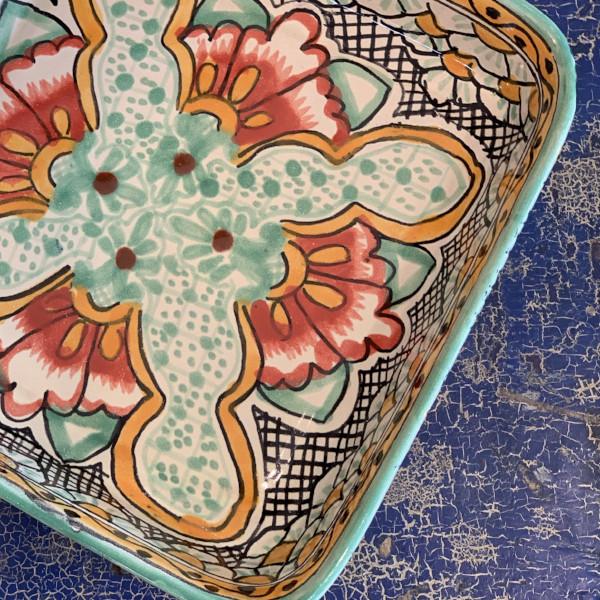This article was written by Leigh Thelmadatter, a Mexico City resident and teacher. She has a great blog about interesting folk artists called Creative Hands of Mexico and this article appeared on the Los Amigos de Arte Popular Facebook Page. I encourage you to follow both!
We have two Day of the Dead pieces by Mr. Camacho right here!
Changing Xochimilco, Changing Occupations, by Leigh Thelmadatter
The change from rural to urban living can cause a kind of identity crises in families. However, some find creative ways to tap into the old to adapt to the new. Alejandro Camacho Barrera comes from a long line of people who worked the land in the south of the Valley of Mexico, in Xochimilco.
From before the Aztecs to until very recently, Xochimilco was an agricultural zone which spent most of its history supplying foodstuffs to a much, much smaller Mexico City, first using Lake Texcoco and as this dried up, canals, then roads. The explosive urban sprawl of Mexico City in the 20th century has has devastating effects on the people as well as the landscape, although Xochimilco struggles to preserve the vestiges of its canals, its festivals and its agricultural heritage.
Don Alejandro’s family story reflects this rapid change. He was an “ejidero,” one with rights to work and live off of an “ejido” or communal property, an arrangement which was formalized just after the Mexican Revolution to ensure that peasant-farmers would have access to land to make a living. However, after a long struggle, the government expropriated the land to establish the Xochimilco Ecological Park with the aim of preserving what little is left of the Valley’s green spaces. As compensation, the Barrio 18 subdivision was established, with each ejidario granted a small plot of land on which to build a house or sell as they chose.
 The development of Barrio 18 has been uneven at the very best, with lots ranging from empty with weeds, to shacks to well-built houses that take up every bit of the small space. It is unusual in the sense that the lots have actual houses in a city where apartments are the norm. However, not all ejidarios have chosen to keep these lots. Its proximity to the Mexico City ring road, Periférico, has raised the value of the land, leading to a split between those who stay and those who leave.
The development of Barrio 18 has been uneven at the very best, with lots ranging from empty with weeds, to shacks to well-built houses that take up every bit of the small space. It is unusual in the sense that the lots have actual houses in a city where apartments are the norm. However, not all ejidarios have chosen to keep these lots. Its proximity to the Mexico City ring road, Periférico, has raised the value of the land, leading to a split between those who stay and those who leave.
For Maestro Alejandro, leaving was not a choice, as he identifies with Xochimilco and the traditions of his family. However, agriculture is no longer an option. Instead, he has turned to handcrafts, in particular the making of toys.
 This kind of work is an extension of what his father and grandfather before him did. Both were carpenters, with his grandfather making “trajineras,” the flat-bottomed boats used on Xochimilco’s canals. This generation began with wood, specifically wood scraps to make toys, but have since expanded into working with other materials, with much of their toy production now in a hard paper mache called cartonería. Toymaking is important to the family not only because of income, but that it allows them to maintain their identity and the traditions of the area. Their production is based on what children in Xochimilco had as those of poor farmers, made from whatever extra materials were available. Their toys include Lupita dolls, puppet figures, miniature animals painted in bright colors, masks and more. Wood and fiber objects are shaped by hand. Most of the cartoneria items are made with molds, but the painting is done completely freehand, with no two pieces turning out exactly the same.
This kind of work is an extension of what his father and grandfather before him did. Both were carpenters, with his grandfather making “trajineras,” the flat-bottomed boats used on Xochimilco’s canals. This generation began with wood, specifically wood scraps to make toys, but have since expanded into working with other materials, with much of their toy production now in a hard paper mache called cartonería. Toymaking is important to the family not only because of income, but that it allows them to maintain their identity and the traditions of the area. Their production is based on what children in Xochimilco had as those of poor farmers, made from whatever extra materials were available. Their toys include Lupita dolls, puppet figures, miniature animals painted in bright colors, masks and more. Wood and fiber objects are shaped by hand. Most of the cartoneria items are made with molds, but the painting is done completely freehand, with no two pieces turning out exactly the same.

Alejandro works with his wife, Miriam and daughter Azul, to make the toys. About a decade ago, the family began winning awards in some of Mexico’s various competitions for artisans including first place in the toy category at the annual competiton sponsored by Mexico’s FONART, the major government entity promoting handcrafts.
Their work in cartoneria has led to expansion into the making of other items, such as alebrijes. They were invited to participate in the annual Monumental Alebrije Parade held in Mexico City, sponsored by the Museo de Arte Popular and were commissioned to make one for the Feria Maestros de Arte. Several of the family’s pieces are part of the permanent collection of the Museo de Arte Popular. In 2015, the workshop was profiled on a major Mexican television show (seen below).
All photographs by the author

